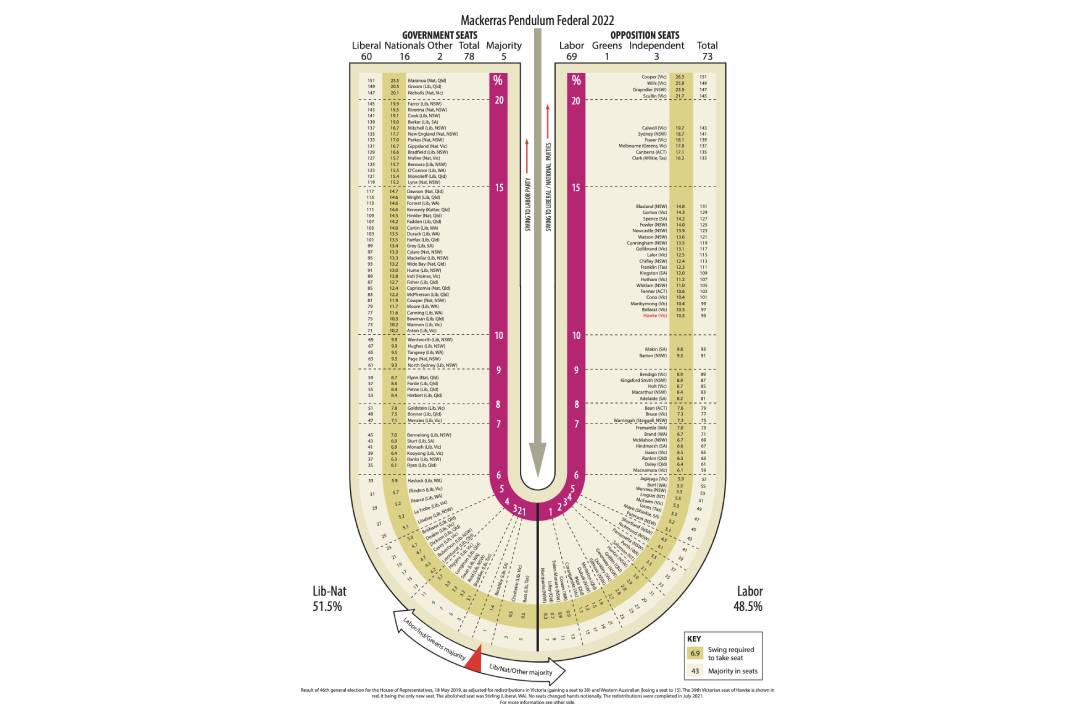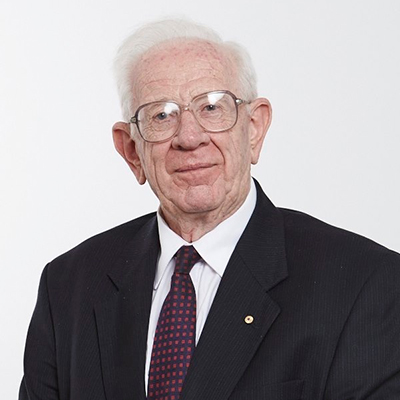

In February 1972 my second book was published by Angus and Robertson titled Australian General Elections. It served as a guide to the December 1972 general election for the House of Representatives which brought Gough Whitlam to the office of Prime Minister. That book reached the bestseller list, and it created the circumstance whereby for fifty years I was generally described as “Australia’s leading psephologist”. That was the first case of the publication of the Mackerras Pendulum which went on to become the standard form for the study of Australian election prospects and analysis.
It is now history to say that the Mackerras Pendulum was widely published in newspapers for the 1972, 1974, 1975, 1977, 1980, 1983, 1984, 1987, 1990, 1993, 1996, 1998, 2001, 2004, 2007, 2010, 2013, 2016 and 2019 federal general elections. During that same period, most state elections also carried a Mackerras Pendulum. For that reason, I think I am entitled to celebrate fifty years of the diagram associated with my name.
Yet even as I celebrate my pendulum, I am compelled to admit that I am no longer “Australia’s leading psephologist”, merely the nation’s “veteran psephologist” at the age of 82. The reason is my expectation that no newspapers will publish the Mackerras Pendulum for this year’s federal election, nor state elections in South Australia in March nor Victoria in November. I shall need to content myself with publication of these pendulums on my website only.
When a newspaper decides to “sack” you (so to speak) it does not need to give an explanation. Thus, when I was “sacked” by The Australian newspaper in May 2016 I received a letter from the then managing editor which merely said: “It is true that we published your pendulum for many years, but we have now taken a different decision”. That kind of message leads me to speculate as to the reasons for the decision by The Australian and, presumably, other papers also.
My first speculation is this: when my career as a public psephologist began in 1957 (my first year out of school) electoral offices provided very little data for information purposes only. Largely as a result of my own work, however, electoral commissions (federal and state) today provide a massive amount of information. Thus, these days any old journalist can easily do that which once needed my skill to do. It is not much use me complaining. Newspapers can save money by not needing to pay me. So, The Australian has replaced my pendulum with a 'Tower of Power' which I think is a badly designed diagram, but I admit that it consumes only about a third of the space once occupied by my pendulum.
With the South Australian election date fixed for 19 March and the campaign well underway The Weekend Australian devoted the whole of its page 8 last Saturday to the SA election. It included three good articles by their SA correspondent, David Penberthy. It also included their standard 'Tower of Power'. Lack of space forbids me from giving details as to why I think their latest 'Tower of Power' is badly designed. More important, however, is this point. The presentation creates the impression that Penberthy did all the calculations. Not so. The paper should have given the source. It is clear to me that the source is Appendix 15 of the 2020 Report of the Electoral Districts Boundaries Commission and that should have been acknowledged.
As to why newspapers no longer seem to love me my second speculation relates to the nature of the party system. Until quite recently we had a system that was unambiguously two-party. In 1972, for example, I had no difficulty about where to place Warringah. It was a blue-ribbon Liberal seat placed on my pendulum just below Bradfield and just above North Sydney. For my current pendulum, however, Warringah (NSW) and Mayo (SA) create a problem I deem “quite minor”, but others would say “serious”. Where do I place them?
My solution is explained in the explanatory notes which accompany my current pendulum. I have decided to treat Mayo and Warringah as though they are Labor seats. Strategists for the Liberal Party would agree with that. Labor strategists, by contrast, would say that Mayo and Warringah should be shown as though they are Liberal seats of about the same strength as Higgins, in Melbourne’s leafy suburbs where Warringah is made up of similar kinds of Sydney suburbs. The point is that I don’t see it as a great problem. Others think the weakening of the two-party system weakens the value of the Mackerras Pendulum.
My third speculation is that critics accuse me of pedantry. Again, Warringah is a good example. I have read in newspapers that there are only two Liberals who seek the honour of being the party’s candidate, a man by the name of Lincoln Parker and a woman by the name of Katherine Deves. The journalist continues: “Warringah is held by independent MP Zali Steggall who holds the Sydney northern beaches seat by a margin of 7.2 per cent.”
I would never write it that way – so let me give the May 2019 statistics. After the full distribution of preferences Steggall had 52,728 votes and Tony Abbott 39,395 votes. In percentages that was 57.24% for Steggall and 42.76% for Abbott. I write that as “the Liberal candidate needs a swing of 7.3% to take the seat from Steggall”. When I want to use a single word, I write: “Steggall sits on a buffer of 7.3%.”
The point about my alleged pedantry is that I am an academic who feels the need to keep my analysis in line with international best practice. I must do that, and my website too must do that. In any other democracy, the analyst who wrote “Steggall sits on a margin of 7.2%” would be describing a vote in which Steggall received 53.6% to Abbott’s 46.4%. In any other country of the Anglosphere that would be a margin of 7.2%.
There are some further points of speculation, but I lack the space here to make them. Suffice it to say if any reader wants my pendulum for the federal election, for the SA election on 19 March or for the Victorian election on 26 November I have copies to give away. Or my reader could visit my website. In the meantime, I insist that the Mackerras Pendulum is the original and the best. I plan to go on producing them. That newspapers seem not to want them merely tells me how low brow all the newspapers have become.
A final point. Where my pendulums use statistics taken from another source that source is always acknowledged.